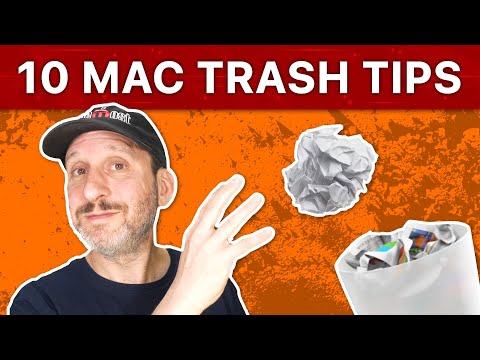Connie Yang is the primary columnist in the computer field at iBoysoft. She is enthusiastic about sharing tech tutorials on data recovery and operating system-related problems resolution. Over the years, Connie has published many computer-related guides and introductory articles.
10 Essential Tips for Managing Trash on Your Mac: A User's Guide Timestamped
1. 00:00 🗑️ Use the Trash on your Mac carefully, as it is the main tool for deleting files and should be treated like a real trash can.
1.1 The Trash on your Mac is the primary tool for deleting files.
1.2 Moving files to the Trash on your Mac is a two-step process and should be treated like a real trash can, only putting files in there if you are absolutely sure you want to delete them forever.
2. 01:22 🗑️ To delete files on your Mac, don't use the Trash as a review process, use Command Delete to move files to the Trash, and then empty the Trash using the Empty button.
3. 02:08 💡 You can empty the Trash on your Mac without opening the folder by using the Finder or keyboard shortcuts, and you can also delete files immediately using the Option key.
4. 02:52 🗑️ Command Delete moves files to Trash, use Command Z to undo, and Command Delete to put files back from Trash to their original location.
5. 04:13 🗑️ Command Delete to move files to Trash, use Put Back to restore and use Delete Immediately to remove specific files without emptying the entire Trash.
If you mistakenly emptied the Trash and want to restore the deleted files, stop making extra operations on your Mac except downloading and installing a data recovery tool like iBoysoft Data Recovery for Mac to try restoring the permanently deleted files.
This program gives you a chance to recover the permanently deleted files on your Mac as long as they haven't been overwritten by new data.
- Download, install, and open iBoysoft Data Recovery for Mac on your Mac.
- Select the startup disk (Macintosh HD) and click Search for Lost Data.
- After scanning, check the scanning files by type.
- Preview and select your permanently deleted files, and then click Recover to save them to an external hard drive
6. 05:05 🗑️ Use List View in Trash to see Date Added, set Mac to automatically delete items after 30 days, and know that Trash is actually two folders.
7. 06:21 🗑️ Files deleted from iCloud Drive and local folders on a Mac are stored in the Trash, which is a combined view of both locations and deleting a file from the Trash will free up space on your drive.
7.1 Files deleted from iCloud Drive and local folders on a Mac are stored in the Trash, which is a combined view of both locations and can also be accessed on iOS and iPad OS devices.
7.2 Files that are local to your Mac won't appear in iCloud, and when you delete a file from the Trash, you will always get the space back on your drive.
8. 08:00 💡 Emptying the Trash on your Mac may not immediately free up space due to the backup process, but you can speed it up by doing a Time Machine Backup.
10 Essential Tips for Managing Trash on Your Mac: A User's Guide Video Summary
🚫 Treating the Trash on your Mac like a temporary storage folder is a mistake - it should be used only for files you are absolutely sure you want to delete forever.
🗑️ You don't have to drag and drop to the trash, use Command Delete for a much easier way to move files.
♻️ You can delete a file immediately without sending it to the Trash by using the keyboard shortcut Option Command Delete.
🔄 You can easily put files back from the Trash using the "Put Back" function, even if the items are from different locations.
♻️ You can set your Mac to automatically delete items from the trash after 30 days, so you never have to worry about emptying it.
🗑️ The Trash folder on your Mac shows a combined view of your iCloud Drive trash and your local drive trash, even though they are in two different locations.
🔄 Deleting a file doesn't actually retroactively pull that file out from your backup because the backup hasn't been updated yet.
The Trash is located on the Dock on your Mac and at the bottom right corner of your screen. You can click the Trash icon on the Dock to access it.
If you want to empty your entire Trash, open it from the Dock and then click the Empty icon at the upper right corner of the Trash window to safely empty Trash on your Mac. If you want to empty several files from Trash, open Trash and then select them. Next, right-click on these files and click Delete Immediately.


